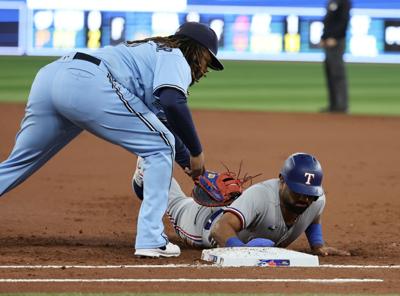The Blue Jays and Rangers are set for another mid-September matchup, the second in as many seasons, but this series won’t have quite the same intensity as the last.
Both teams were in the thick of last year’s wild-card race. They expected to be in the same spot, if not better, this season. Instead, they’re integrating rookies and playing out the string after falling out of contention months ago.
Tuesday’s series opener in Texas will be a battle between two of Major League Baseball’s biggest disappointments: the Rangers, who went from winning a World Series to a distant third place in their own division, and a Jays team that cratered after back-to-back trips to the playoffs.
Exciting, huh?
With two weeks remaining in the regular season, the Jays and Rangers are essentially in the same place with one game separating them in the standings. They have similar strengths and weaknesses, but the noticeable difference has been health.
The Rangers have been decimated by injuries. Some were expected as ace Jacob deGrom and righty Tyler Mahle rehabbed from major surgeries. Others — to right-hander Jon Gray, third baseman Josh Jung and shortstop Corey Seager — were not.
While the Jays have had injuries, too, that hasn’t been the primary cause of this year’s failures. Losing closer Jordan Romano was a setback, but he alone would not have saved one of MLB’s weakest bullpens. In other years, shortstop Bo Bichette getting hurt would have been catastrophic, but by the time it happened the season was all but over.
Elsewhere, the Jays remained relatively healthy. First baseman Vladimir Guerrero Jr. dealt with nagging ailments but has been available all year. For the first time since arriving as a free agent in 2021, outfielder George Springer hasn’t required a stint on the injured list. Two years in a row, the only major blow to the rotation was the loss of Alek Manoah.
There were some minor issues — losing former starting catcher Danny Jansen for a couple of weeks in early April, and arm injuries to relievers Chad Green and Erik Swanson — but none serious enough to derail an entire year.
, the Rangers have missed a combined 1,769 days because of injuries, third-most in MLB. Their total cost for those missed days in salary also leads the majors at $89,387,394 (U.S.) while the tally of 23 injured players ranks 10th.
Compare that to the Jays, who have seen 11 players go down with injury. No roster had missed fewer games than their 602 entering Monday’s off-day, while the salary total ranks 24th at $17,155,101. That’s quite an achievement for an organization that opened the season with a $225-million payroll,
The Rangers also have some valid excuses for their poor play. Right-hander Max Scherzer has made just nine starts in his final year before free agency. Gray barely topped 100 innings. Outfielder Adolis Garcia went from an all-star to a guy hitting .216 with an on-base plus slugging percentage that’s well below average. Last season, Jung contended for rookie of the year; this year, he has barely played. Second baseman Marcus Semien hasn’t been himself.
It has been a difficult year, but overall the Rangers don’t have too much to complain about. They won a title in 2023 and a banner was added to the rafters. The hangover was well worth the celebration that came before.
If only the same thing could be said about the Jays. This was supposed to be their golden era. The goal wasn’t to win one World Series, it was to win several and become a dynasty. Six years after Guerrero and Bichette arrived, the franchise has three post-season appearances and zero wins to show for it.
The Rangers can take additional comfort in knowing deGrom should be healthy to start next year. Seager and Semien remain under control through at least 2028, and bounceback seasons will be expected from Garcia, Jung and catcher Jonah Heim. Equally important, the Rangers’ guaranteed contracts are set to drop from about $232 million to $127 million, which could lead to an active off-season.
The Jays possess financial flexibility, too. They have $115 million in guaranteed contracts next season, but paid out $45 million to arbitration-eligible players this year and that number will only grow in 2025. More problematic, unlike the Rangers, they don’t have any core position players locked up long term.
This season has been a failure for both teams — there’s no sugar coating it — but the Rangers shouldn’t feel too guilty. They have a ring and some justifiable reasons behind this year’s disappointment. Meanwhile, all the Jays have done lately is watch their window of opportunity continue to close.




























To join the conversation set a first and last name in your user profile.
Sign in or register for free to join the Conversation